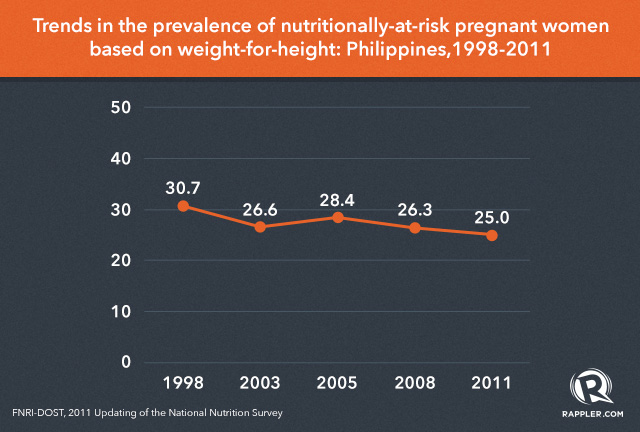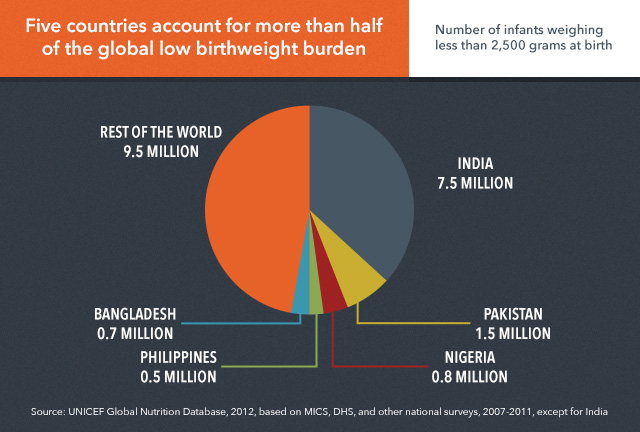SUMMARY
This is AI generated summarization, which may have errors. For context, always refer to the full article.

MANILA, Philippines – The Philippines is the 5th country in the world with the most cases of low birthweight infants, according to a 2013 report by the United Nations Children’s Fund (Unicef).
This is a consequence of poor nutrition among women before and during pregnancy.
The World Health Organization (WHO) says that low birthweight babies are at more risk of health problems manifested not only during early development stages but also until adulthood.
If this trend persists, not only women and children are put in peril, but also the entire country’s future workforce.
The lack of investment in women’s health may result in a weak, sickly, and dull population, ultimately putting a strain on the Philippine economy, education, and development.
At present, it seems that the long road to achieving the Millennium Development Goals (MDGs) by 2015 – including the improvement of women’s and children’s health – will be a bumpy one.
Double responsibility
“The health and survival of mothers and their newborns are linked,” Unicef stressed.
A pregnant woman must satisfy not only her own nutritional requirements but also those of the growing fetus in her womb.
Her nutritional status affects her child’s health at birth. This crucial period can also determine growth and development in the years to come.
All of the baby’s nutrition needs come from the mother. Insufficient nutrition could lead to different problems such as stunting which refers not only to hindered physical growth, but also to impaired cognitive abilities. Stunting refers to having a lower height for one’s age and is caused by long-term insufficient nutrient intake. It occurs before the age of two and its effects are irreversible.
Unicef reported that 80% of the world’s stunted children live in 14 countries, among which the Philippines ranked No. 9. As of 2011, 33.6% of Filipino children under 5 years old were stunted.
| Possible impacts of undernourishment on pregnant women | Possible impacts of undernourishment during pregnancy on babies |
|---|---|
| Anemia | Brain damage |
| Increased risk of hemorrhage | Still births |
| Miscarriage and premature delivery | Stunted growth/Development retardation |
| Weak immune system | Continuing malnutrition |
| Lower resistance to infections | Anemia |
| Easy fatigue | Goiter |
| Higher risk of complications and death | Increased risk of infection/illnesses |
| Cognitive impairment and lower IQ; premature or low birth weight |
During pregnancy, a woman’s body prioritizes the baby’s nutrition needs.
For example, if the mother is anemic, her hemoglobin count may further drop since the baby inside her also needs hemoglobin for oxygenation. This may compromise the health of both mother and baby.
Unicef advises mothers to receive micronutrient supplements, extra food and fluids “to rebuild their own nutrient stores.”
Pregnant women should focus on their health and nutrition needs to prevent difficult labor and complications such as severe hemorrhage, infections, high blood pressure, and abscesses of the breasts, according to the Food and Nutrition Research Institute of the Department of Science and Technology (FNRI-DOST).
Pregnant and nutritionally at risk
In the Philippines, one out of every 4 pregnant women is nutritionally at risk, FNRI-DOST reported in its most recent survey in 2011.
Close to one-fourth or 23.5% of pregnant mothers with children 0-5 years old are also at risk and 11.8% of lactating mothers are underweight, the same survey said.

These figures barely changed in the past decade, reflecting the country’s slow progress in improving the health and nutritional status of pregnant women.
Poorly nourished mothers will also most likely give birth to low birthweight infants – those weighing less than 2,500 grams at birth.
Low birth weight

The incidence of low birthweight exceeded 20% in the Philippines; the same was observed in India and Pakistan, according to Unicef. The figure is alarming, considering that these unhealthy infants will someday grow to be our society’s backbone.
This can also have adverse effects on the economy. WHO suggests that low birth weight results in “substantial costs to the health sector and imposes a significant burden on society as a whole.”
According to FNRI-DOST, 20.2% of Filipino children under 5 years old were underweight in 2011. The MDG target is to reduce this number to 17.3% in 2015. The probability of the Philippines achieving this goal is said to be “medium.”
The Philippines is the 10th country in the world most affected by wasting or having low weight for one’s height. Wasting is an acute form of malnutrition and increases the risk of death among children.
In 2011, 7.3% of Filipino children under 5 years old suffered from wasting.
Making the right food choices
Milagrina Jacinto, president of the Department of Health (DOH) League of Licensed Nutritionist-Dietitians Inc. and head of the Nutrition and Dietetics Service of the Quirino Memorial Medical Center (QMMC), emphasized the importance of eating the right quality and quantity of food during pregnancy.
“Pregnancy is a crucial period. The mother is not only feeding herself, but also the baby inside her womb,” Jacinto said.
Jacinto clarified the misconception that eating healthy means spending more money. “In terms of quality, it doesn’t mean you eat the most expensive food. For example, you can substitute meat with other protein-rich foods such as legumes like monggo, or with tofu, eggs, or fish. The nutrients are important, not the price.”
Families may grow fruits, whole grains, and green leafy vegetables such as kangkong, malunggay, and sweet potatoes in their backyards. These simple yet nutritious foods can contribute to the strengthening of the immune system.
Giving pregnant mothers food and micronutrients would improve their nutritional status as well as store the micronutrients necessary for their fetuses and eventually, their newborns.
Well-informed, well-nourished
A well-informed and well-nourished mother can better nourish her baby.
Education also plays a vital role in keeping a country healthy. Everyone, not just mothers, must be aware of their nutrition needs as well as the simplest and best ways to meet those needs.
Jacinto said government hospitals, like QMMC, offer free programs that educate pregnant women, such as counseling services, one-on-one consultations with nutritionist-dietitians, and forums and lectures on pregnancy, health and nutrition.
Because hospitals and LGUs vary in the free services they offer, the public must not hesitate to ask what these programs are.
Pregnant women, Jacinto added, should inquire about maternal care programs, antenatal care, post-partum care, immunizations, feeding programs, micronutrient supplementations, and other services available in their community.
The government, together with schools, local government units (LGUs), the media, non-governmental organizations (NGOs), private sectors, and the general public must work together in raising health and nutrition awareness, Jacinto said. – Rappler.com
Add a comment
How does this make you feel?
There are no comments yet. Add your comment to start the conversation.